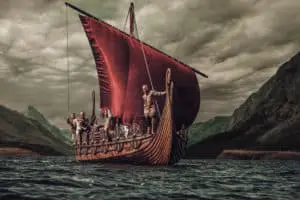The Spice Trails: Following Flavours from East to West – A Culinary Journey
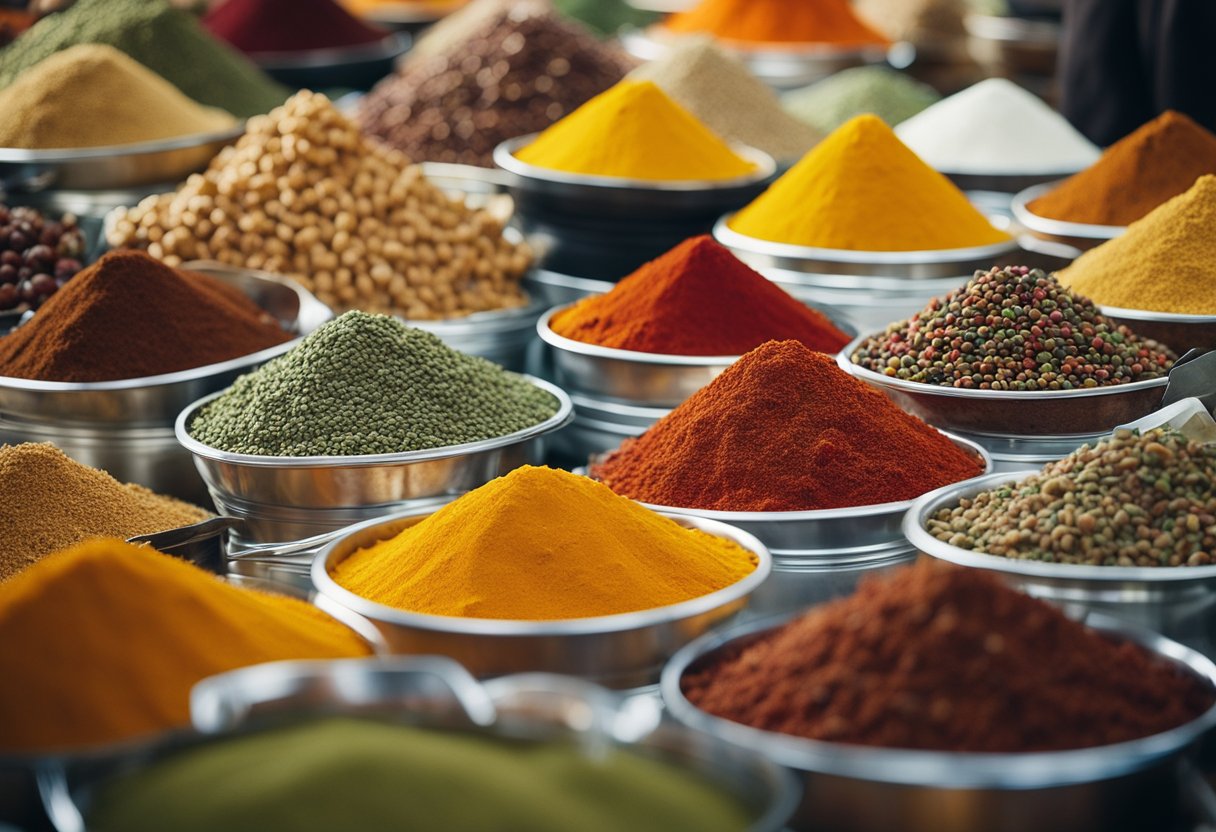
Updated On: April 22, 2024 by Marwa Alaa
The Spice Trails are a captivating journey through history that traces the trade routes of the most sought-after flavours across the globe. These ancient pathways, extending from the Far East to the Western world, reveal a story of human endeavour, cultural exchange, and economic evolution that transformed civilisations. Our exploration begins with the origins of these historic routes, which were essential channels for the movement of exotic spices such as pepper, cinnamon, and cloves, highlighting the integral role they played in the development of global trade.
As we navigate the aromatic paths of the Spice Trails, we uncover the profound impact they had on both Eastern and Western cuisines. The exchange of spices led to a culinary revolution, allowing for the creation of new flavours and cooking techniques. This intermingling of tastes and traditions resulted in a rich tapestry of dishes that continue to shape modern cooking. Moreover, the intersections along the Spice Trails gave rise to vibrant markets and trading centres—places that became melting pots of diverse cultures and provided a backdrop for historical explorations and adventures.
The History and Origin of the Spice Trails
In tracing the beginnings of the spice trails, we uncover a journey that spans across continents and civilisations, deeply intertwined with the growth and development of societies throughout history.
Ancient Civilisations and Spice Use
Spices have been a significant part of ancient civilisations for thousands of years. Egyptians utilised myrrh and cinnamon in embalming practices, highlighting their intrinsic value beyond flavouring and even in spiritual realms. The Chinese and Indians, too, incorporated a variety of spices like ginger and clove into their medicinal and culinary applications from as early as 2000 BCE, signifying spices as a cornerstone of cultural traditions.
The Emergence of the Spice Trade
The spice trade began to take shape in the Middle Eastern and South Asian regions. Two key players, cinnamon and clove, were among the earliest commodities traded from the Moluccas—the historic ‘Spice Islands’—and Sri Lanka, marking the start of an intricate network of routes. This spice route stretched from the East Indies to the Middle East, North Africa, and Europe. It was not just a trade of goods but an exchange of knowledge, culture, and power, carving pathways that would reshape the world’s socioeconomic landscape through ancient and medieval periods.
Cultural and Culinary Impact
The Spice Trails were not only routes for trade but also pathways for remarkable culinary and cultural exchanges. Through these vibrant corridors, spices have woven a rich tapestry of flavour and tradition into the global culinary landscape.
Spices in Culinary Traditions
Spices have been the cornerstone of culinary traditions across the world. For instance, the use of cinnamon, a spice sourced from the inner bark of certain tree species, has been a defining feature in the cuisines of Europe and Asia. In Europe, spices from the East were eagerly incorporated into local dishes, transforming the regional culinary landscape. These aromatic ingredients were responsible for the development of signature dishes that remain beloved to this day.
From the warming glow of cinnamon in British apple pies to the fiery kick of pepper in Indian curries, spices have shaped the distinctive flavours of cuisines globally, fostering a deep and lasting cultural exchange. The following table summarises some traditional uses of common spices:
| Spice | Culinary Use |
|---|---|
| Cinnamon | Adds a warm, sweet aroma to pastries and desserts. |
| Pepper | Enhances savoury dishes with its sharp, piquant taste. |
| Cardamom | Imparts a refreshing, citrusy note to Scandinavian and South Asian dishes. |
Medicinal Qualities and Ritual Uses
Beyond their culinary applications, spices have long been prized for their medicinal properties. Traditionally, cinnamon has been used for its potential to regulate blood sugar levels, while cardamom is known for its digestive benefits. Spices like cloves have been linked to antiseptic and analgesic properties, often utilised in various healing practices.
The ritualistic use of spices has been integral to cultural traditions across the globe. Incense containing spices like cinnamon and cloves is often found in religious ceremonies, providing a profound sensorial experience that connects participants with their spirituality. These rituals have transcended time, maintaining a significant impact on cultural practices and medicinal use.
By acquainting ourselves with the Spice Trails, we acknowledge the profound influence of these aromatics on our health, rituals, and the global tapestry of cuisines, underscored by a legacy of cultural exchange and tradition.
The Spice Routes and Global Trade
The Spice Routes fundamentally shaped the contours of global trade, intertwining the destinies of East and West through commerce.
Key Trade Routes
Spice routes were a complex network of trade routes that linked the Eastern and Western worlds, primarily during the Middle Ages. These routes traversed vast and diverse terrains, including oceans and continents, to deliver precious spices from the East to an eager market in the West.
- By sea, traders navigated from the west coast of Japan, around the Indonesian archipelago, skirting India, and towards the Middle Eastern lands before reaching the Mediterranean to distribute their goods in Europe.
- The overland routes were equally essential, with spices moving through China, over the Silk Roads, and into the bustling markets of Eurasia.
Each node along these routes acted not just as a trading post but also as a cultural exchange point, profoundly influencing the local economies and social structures.
Economic and Political Power of Spice Trade
The trade-in spices such as cinnamon, pepper, and cloves was not merely an economic activity—it catapulted nations into positions of formidable power.
- Economies of entire regions hinged on these commodities, with Venice and Genoa rising to prominence through savvy control of the spice trade in the Mediterranean.
- The political landscape of the time was shaped by this trade. European powers, recognising the economic advantage to be gained, embarked upon an era of exploration aimed at finding new, direct routes to the coveted spice markets of the East.
The value of the spice trade is evident in not only the financial wealth it generated but also in the enduring political alliances and rivalries forged on the back of these precious commodities. The legacy of the spice trade continues to resonate in our global trade networks today.
Major Spices and Their Origins
In this section, we’ll take a closer look at some of the world’s most cherished spices, their origins, and the regions that have become synonymous with their cultivation.
Profiles of Essential Spices
Cloves: Native to the Maluku Islands, also known as the Spice Islands in Indonesia, cloves have been a prized spice for over 2,000 years. Their warm, sweet, and aromatic essence is unmistakable and has made them a staple in kitchens globally.
Nutmeg: Indigenous to the Banda Islands of Indonesia, nutmeg is another Spice Islands gem. This versatile spice, with its warm and slightly sweet taste, has graced both sweet and savoury dishes since ancient times.
Pepper: Often referred to as “black gold,” black pepper originates from India, especially the Malabar Coast, making it one of the oldest and most traded spices in history.
Cumin: Cumin’s earthy, pungent flavour is associated with the culinary traditions of the Middle East and India, where it has been used since antiquity.
Coriander: Its use dates back to 5,000 BC. Coriander, known for its citrus-like flavour, has roots in the Mediterranean and Middle East regions.
Turmeric: This vibrant golden spice, a member of the ginger family, is native to India and South Asia. It is beloved not only for its flavour but also for its myriad health benefits.
Cardamom: Known as the “Queen of Spices,” cardamom hails from Southern India and Sri Lanka. It’s highly aromatic and has a sweet, eucalyptus-like flavour.
Ginger: A fiery and pungent spice, ginger originates from Southeast Asia and has been cultivated for millennia for both its culinary and medicinal properties.
Saffron: Deriving from the Crocus flower, saffron is a highly precious spice indigenous to Greece and Southwest Asia. It’s celebrated for its unique, slightly bitter flavour and intense colour.
Regional Specialties
- Indonesia: This archipelago is famed for its rich variety of spices, including cloves and nutmeg, which were amongst the most sought-after commodities during the age of the Spice Trade.
- Sri Lanka: Known for its high-quality cinnamon and cardamom, Sri Lanka has been a key player in the spice market since ancient times.
- China: China has cultivated ginger since the 4th century BCE and is revered for its Sichuan pepper.
- India: The subcontinent is the birthplace of several spices, such as pepper, cumin, turmeric, and coriander, making it an essential part of the global spice narrative.
Significant Spice Trading Nations
As we explore the history of the spice trade, two nations stand out for their formidable roles: Portugal and the Netherlands. These European powers were key players in shaping the routes and the trade that connected the East and West.
The Power of the Portuguese
Portugal became a prominent figure in spice trading during the Age of Discovery. Under the leadership of Prince Henry the Navigator, Portuguese explorers such as Vasco da Gama pioneered sea routes to India, bypassing the overland routes dominated by Venice. This direct sea route was pivotal, securing a Portuguese monopoly in the spice trade that would prosper for over a century.
Through their control of maritime trade routes, Portugal amassed wealth and influence, crucially positioning itself in the global spice market. The country’s traders operated out of key ports like Lisbon, creating vast trading networks that not only distributed spices but also spread European influence throughout the East Indies.
The Power of the Dutch
The Dutch took over as the leading spice trade nation following the decline of Portuguese dominance. The Dutch East India Company (Vereenigde Oostindische Compagnie or VOC), established in the early 17th century, is often cited as one of the world’s first multinational corporations.
Their systematic approach to trade, advanced fleet, and the establishment of trade colonies throughout the Indonesian archipelago allowed the Netherlands to control the spice trade, especially nutmeg, mace, cloves, and cinnamon. Dutch traders not only monopolised these goods but also enforced their power, often through aggressive tactics, to maintain their influential position in the trade for years.
Portugal and the Netherlands exemplify how the quest for spices prompted not just economic but also geopolitical shifts as European powers jockeyed for control of these valuable resources.
Culinary Fusion and the Exchange of Flavours
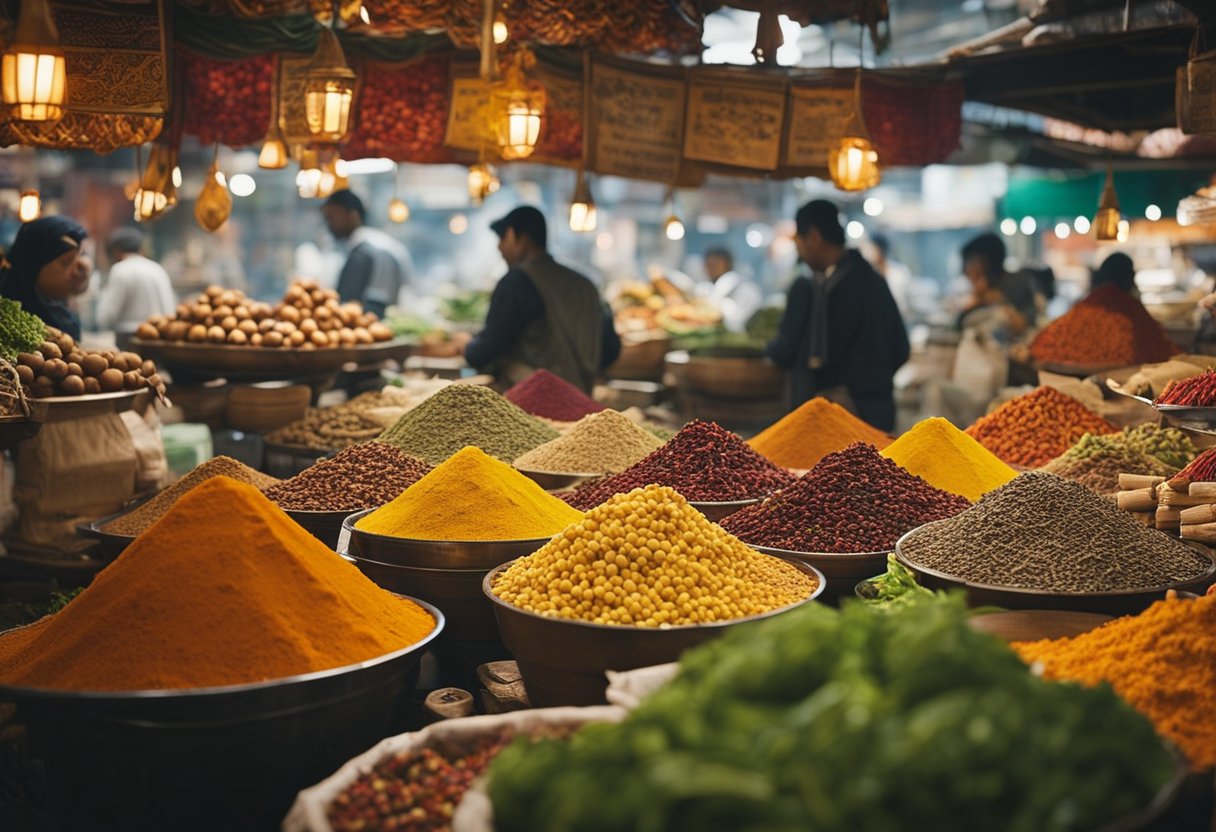
The Spice Trails have not only connected cultures through commerce but have also paved the way for the creation of new culinary traditions. The exchange of spices and recipes across continents has given rise to vibrant fusion cuisines and the evolution of time-honoured dishes.
Fusion Cuisines Across Continents
Fusion cuisine represents the blending of culinary worlds, where the spices and cooking methods of one culture merge with another. This harmonious melding often results in dishes that are ground-breaking in taste and presentation. For example, Indian cuisine, known for its robust spice usage, has influenced creations like Anglo-Indian curry dishes, which combine British tastes with traditional spices. Similarly, chifa is a testament to Chinese influence in Peruvian cooking, incorporating soy sauce and ginger with native Peruvian ingredients.
Evolution of Traditional Dishes
Traditional dishes often evolve when exposed to new spices and ingredients, leading to the creation of distinct flavours. Thai cuisine, for instance, has embraced a complex interplay of sweet, sour, salty, and spicy tastes, sometimes incorporating Szechuan pepper, a hallmark of Chinese cooking. Through such exchanges, conventional recipes are reimagined, giving them new life in a modern context. It is fascinating to observe how traditional Chinese dishes have adapted through the introduction of Southeast Asian flavours, leading to the popularisation of recipes that offer a delicate balance between the familiar and the exotic.
The Role of Spices in Modern Cooking
Spices have transcended their historical trade value to become irreplaceable elements of modern cooking. They impart unique flavours and a depth that elevates dishes from the mundane to the extraordinary.
Contemporary Use in Global Cuisines
In global cuisines, spices are more than flavour enhancers; they are cultural signatures that convey the essence of a region’s palate. We see chefs and home cooks alike celebrating the infusion of exotic flavours across a myriad of dishes. Turmeric, cardamom, and saffron, to list a few, are widely used for their bold, earthy notes and vibrant colours, giving meals a visual and sensory appeal. Complex blends such as garam masala and five-spice introduce a layered experience of taste, subtly changing with each bite.
- Turmeric: Adds a bright yellow hue and a warm, bitter taste to curries and rice dishes.
- Cardamom: Infuses desserts and teas with a sweet, floral fragrance.
- Saffron: Imparts a rich, golden colour and a distinctive hay-like taste to risottos and paellas.
Spice Influence on Cooking Techniques
Spices also deeply influence cooking techniques, contributing to the savour and complexity of a dish. For instance, toasting spices can unlock their aromatic oils, enhancing the dish’s depth. Slow cooking, on the other hand, allows the full range of spice flavours to penetrate and improve the dish’s overall profile. With the rise of experiential dining, there’s a renewed focus on using spices to create interactions between the consumer and the cuisine.
- Toasting: Releases essential oils and heightens the flavour profile.
- Slow Cooking: Ensures spices thoroughly permeate the dish for an intense taste.
In modern cooking, mastery of spice use is a testament to a chef’s skill in delivering dishes that are richly infused with an intricate tapestry of flavours, each bite meant to evoke a sense of place and tradition, making every meal an aromatic journey.
Distinctive Markets and Trade Centres
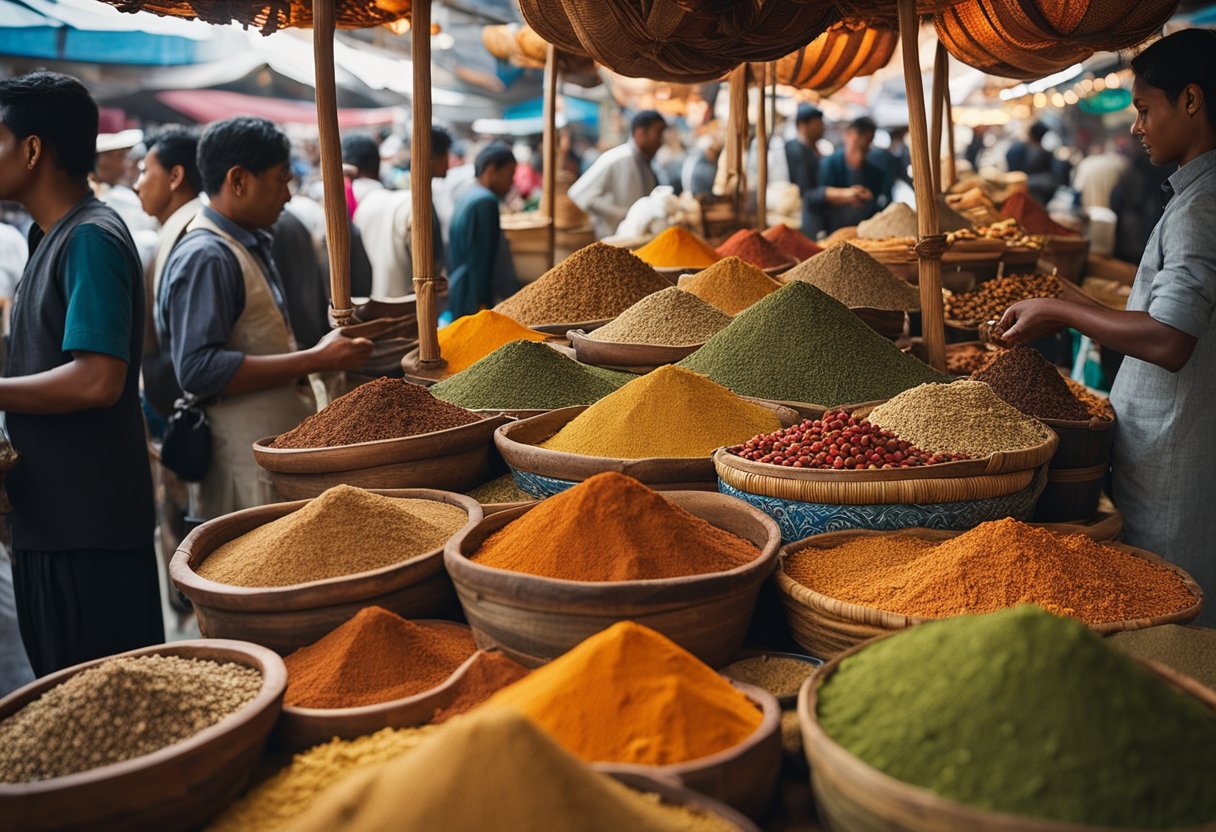
At the heart of the spice trade, vibrant markets and bustling trade centres have long established economic and cultural exchanges between East and West. Through these hubs, spices such as pepper, cinnamon, and cardamom travel from their native lands to spice up cuisines and economies across the world.
Famous Markets and their Histories
Historically, markets like the bazaars of the Middle East and the mercantile ports of the Mediterranean played pivotal roles in the spice trade. These markets were not just centres of commerce but also melting pots of diverse cultures. The city of Constantinople (now Istanbul), for instance, acted as a key gateway between Europe and Asia, fuelling the spice demand in European countries.
Traders from India and beyond would bring their precious cargo to these markets, where they were met with great anticipation and competition. This often led to a veritable race among European nations to establish direct trade connections. The history of these markets is steeped in tales of adventure, with the vivid aroma of spices often signifying the wealth and status of those who possessed them.
Modern Trade and Spice Availability
In today’s global landscape, traditional markets have evolved, but the principles of supply and demand remain unchanged. Spices that once took months to travel from East to West are now readily available, thanks to modern logistics and trade partnerships. Europe continues to be a major destination for spices, with the European Union being the largest importer and consumer of spices from India and the Middle East.
Contemporary trade centres are epitomised by efficiency and accessibility, with the once-exotic spices of the ancient trails now gracing supermarket shelves across the continent. As customers, we benefit from a historical legacy that permits us to cook with flavours that were once the preserve of the very wealthy, now available to all due to the enduring connections established by our forebears.
Influence of the Spice Trails on Western Cooking
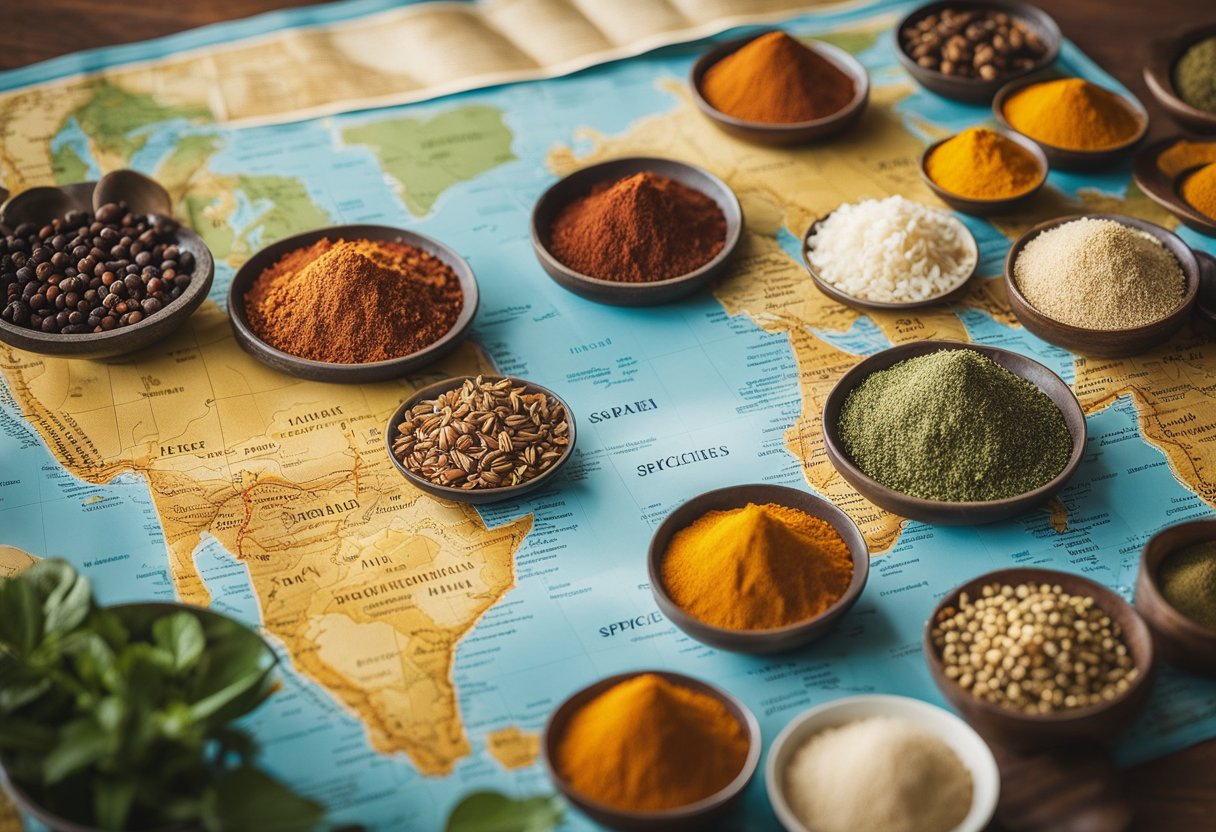
The Spice Trails historically bridged the East and West, profoundly influencing Western gastronomy through the introduction and adoption of aromatic flavours.
Adoption of Spices in Western Cuisines
The age-old Silk Road was a conduit for more than just trade; it was the route through which the West first encountered the allure of Asian spices. This encounter steered European cuisine into an era of transformation. Key ingredients such as cinnamon, pepper, and nutmeg, once at the heart of Eastern cooking, began to weave themselves into the fabric of Mediterranean dishes, leading to a budding appreciation for these exotic elements.
The fusion of spices into Western culinary practices marked a bold departure from their prior gastronomic traditions. Spices that were highly prized for their preservation properties and medicinal value soon became staples in Western pantries. Their incorporation into everyday cooking can be seen in dishes that still symbolise Mediterranean and European cuisine to this day.
The influence of spices has been deeply felt not just in flavour but also economically and culturally. Spices carried along these ancient trade routes symbolised wealth and status in the West for centuries. As appreciation grew, so too did the desire for variety, leading Western gastronomy towards a more complex and nuanced palate.
This embrace and incorporation of spices allowed for a rich, more vibrant culinary landscape to flourish across Western Europe. Our tables are a testament to this age-old influence, celebrating each spice’s journey from faraway lands to become a cornerstone of Western cooking.
Historical Explorations and Adventures
In this section, we trace the thrilling voyages that reshaped the world through the pursuit of spice. These expeditions were fraught with peril but driven by the promise of wealth and uncharted territories, defining an era of European exploration.
Voyages of Discovery
Voyages in the Indian Ocean marked the dawn of a new era in the late 15th century. The Portuguese explorer Vasco da Gama embodies the spirit of this age; in 1498, he became the first European to reach India by sea. This groundbreaking voyage paved the way for future explorers and set the stage for the age of discovery.
These daring adventures led by explorers like da Gama were fuelled by the desire to secure direct trade routes to the Spice Islands, now known as the Maluku Islands of Indonesia. The spices they carried back transformed cuisines and economies, igniting an age of colonisation and competition among European powers.
The Spice Trails not only reshaped global trade but also left an indelible mark on the cultures and politics of the regions they touched, often with complex and lasting legacies. Through these journeys, European explorers charted seas and mapped the contours of the known world, forever altering the course of history.
The Enduring Legacy of the Spice Trails
The Spice Trails have left an indelible mark on world history and cuisine, shaping the knowledge and ideas that flow from East to West.
Lasting Influence on World History and Cuisine
The journeys of spices such as cloves from Southeast Asia and cardamom from East Asia have left a deep legacy in our global history. We recognise the Spice Trails as catalysts for exploration and trade, which have forever altered our global understanding. They introduced a treasure of flavours to the world, leaving a legacy in culinary traditions that extends far beyond their original borders. Spices like pepper and cinnamon from Central Asia became household names, integrating into dishes around the world and remaining essential ingredients in both modern and traditional recipes.
Continued Interest and Study
Today, our interest in the Spice Trails continues unabated; they are a historical pathway begging to be explored further. Enthusiasts and scholars alike pursue an understanding of these ancient routes, unearthing knowledge that broadens our comprehension of cultural exchanges. We celebrate this history, delving into its complexities and connections that remind us of an earlier version of today’s globalised world. We believe that by studying the past, we can gain valuable insights into the intricate web of intercultural communications and trade that have shaped our society.
Frequently Asked Questions
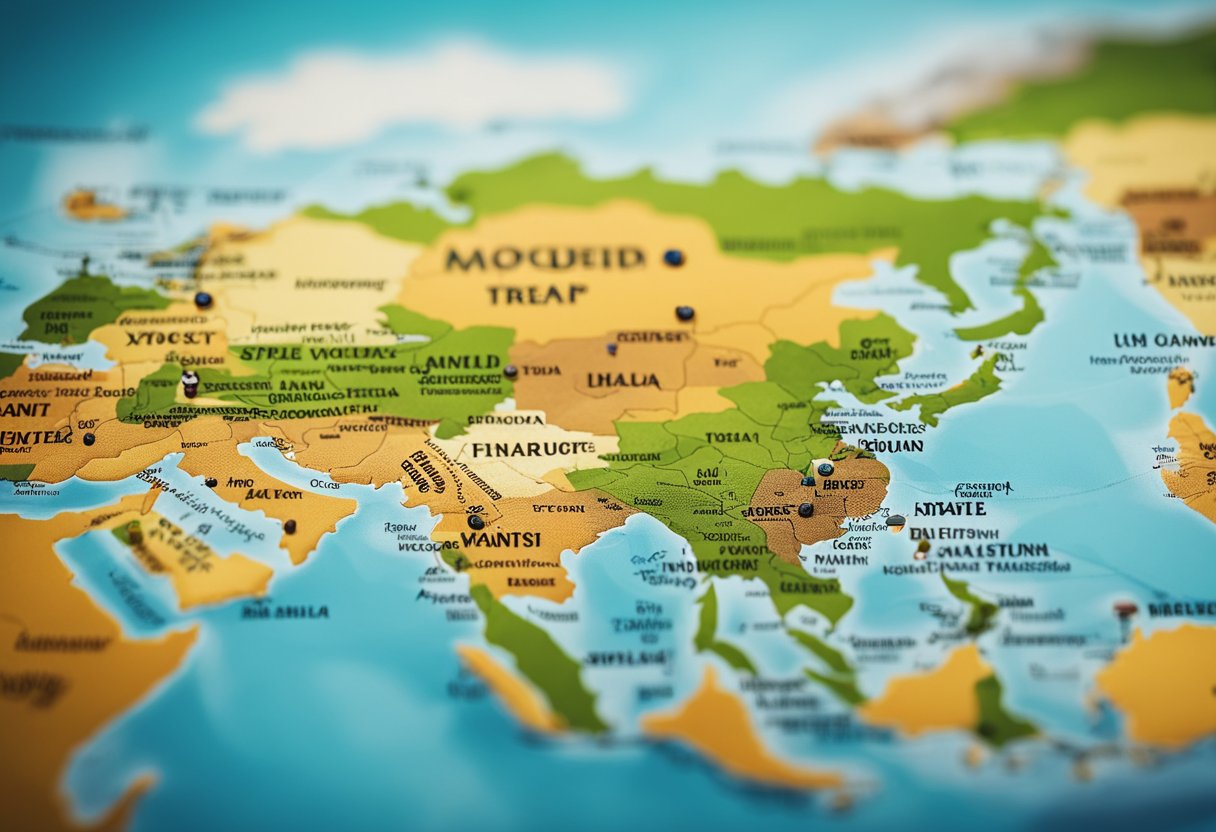
As we explore the history and impact of the Spice Trails, we often encounter recurring inquiries that reflect the significance of this trade network. Below are some answers to these common questions.
What commodities were exchanged along the ancient Spice Route?
The ancient Spice Route was primarily known for transporting spices like cinnamon, cardamom, ginger, and black pepper. However, other commodities such as silk, precious stones, and metals were also traded on this network.
How did the Spice Routes contribute to early globalisation?
The Spice Routes facilitated some of the earliest forms of globalisation by connecting diverse cultures and economies. They enabled the spread of goods, ideas, and cultural practices across Eurasia, laying the groundwork for the interconnected world we inhabit today.
What is the history of the Spice Routes during the 7th to 15th centuries?
Between the 7th and 15th centuries, the Spice Routes expanded as Islamic traders took control of the trade in the Middle East and beyond. This period also saw the rise of powerful port cities and the increased demand for spices in Europe, which ultimately led to the Age of Exploration.
Why was the trade in spices such a significant factor in shaping world history?
The trade-in spices was a significant factor in world history due to the high demand and lucrative nature of spices in the Middle Ages. They were valuable not just for culinary use but also for their medicinal properties and as a symbol of wealth and status in Europe.
Which exotic spices were commonly transported from the East to Europe?
Exotic spices such as nutmeg, mace, cloves, and star anise were coveted commodities that were commonly transported from the East to satiate Europe’s burgeoning demand for spices.
Can you describe the navigation of the New Spice Route?
With the advent of the New Spice Route, European navigators such as Vasco da Gama found sea paths to the East, circumventing the traditional land routes dominated by Middle Eastern merchants. This sea route was pivotal in establishing direct trade links between Europe and the spice-producing regions.






